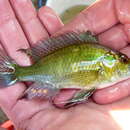en
names in breadcrumbs


Astatotilapia calliptera, the eastern happy or eastern river bream, is a species of haplochromine cichlid from southeastern Africa.
The male Astatotilapia calliptera has blue lips and a dark line through its eye. It can show a reddish forehead but the body is normally yellow, although some wild populations are blue.[3] The females are smaller than the males and are brownish silvery in colour.[4] The maximum total length is 15 cm (5.9 in).[5]
Astatotilapia calliptera occurs in Lake Malawi and its drainage, the Shire River, and Lakes Chiuta and Chilwa. It has also been recorded from the lower Zambezi River,[5] and in coastal rivers on the coastal plain of Mozambique, from the Rovuma River and south as far as the Save River,[1] This species is established as a non-native, introduced species in Broward County and Palm Beach County in Florida, United States.[6]
Astatotilapia calliptera prefers shallow water with a sand substrate with aquatic vegetation such as species of Vallisneria,[3] where it can be abundant. It is most common in the lower reaches of rivers and weedy flood lagoons.[1] It is an omnivore and much of its diet consists of detritus and phytoplankton;[3] they will also eat invertebrates, algae and smaller fishes.[5]
They are mouthbrooders in which the female lays her eggs on a hard substrate and then they are inseminated by the male before the female takes them into her mouth where they stay for 12-14 days before hatching. The young are then guarded by their mother for a further 5-6 days, using her mouth as a refuge when they perceive danger.[5]
Astatotilapia calliptera was one of the first cichlid species found in the aquarium trade.[4][7] A number of colour varieties are available.[4]
Astatotilapia calliptera, the eastern happy or eastern river bream, is a species of haplochromine cichlid from southeastern Africa.